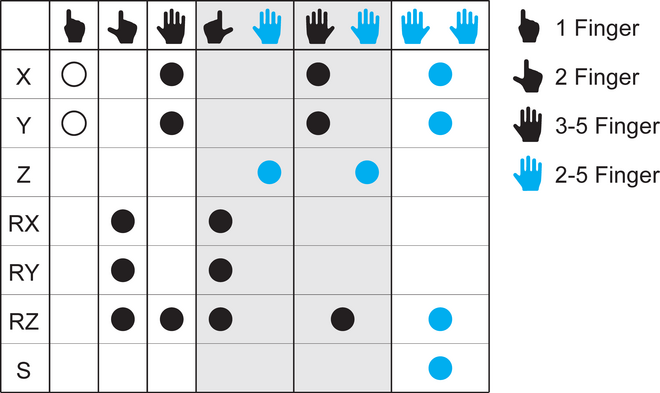Abstract
We present a comprehensive multitouch input mapping for 3D navigation of multiscale 3D models. In contrast to prior work, our technique offers explicit control over 3D rotation, 3D translation, and uniform scaling with manipulative gestures that do not require graphical widgets. Our proposed technique is consistent with the established RST mapping (rotation, scaling, translation) for 2D multitouch input and follows suggestions from prior work on multitouch 3D interaction. Our implementation includes a rendering technique that can reduce perceptual conflicts of 3D touch input on stereoscopic displays. We also report on two user studies that informed the suggested interaction design and confirmed its usability.
Our research has received funding from the EC FP7 project 3D-PITOTI (ICT-2011-600545) and the German Federal Ministry of Education and Research (BMBF) under grants 031PT704X (project Big Data Analytics) and 03PSIPT5A (project Provenance Analytics). We thank the participants of our studies, the members of the 3D-Pitoti project, and the members and students of the Virtual Reality and Visualization Research group at Bauhaus-Universität Weimar.
Publication
Kulik, A., Kunert, A., Keil, M., Froehlich, B. RST 3D: A Comprehensive Gesture Set for Multitouch 3D Navigation. In Proceedings of the 25th IEEE Conference on Virtual Reality and 3D User Interfaces, VR 2018, pp. 363-370, Reutlingen, Germany, 2018. IEEE Computer Society. DOI: 10.1109/VR.2018.8447554
Multitouch Gestures for 3D Transformations and Scaling
Multitouch 3D navigation on a large rock panel with small figures. Input gestures with one or two hands (> 2 fingers) correspond to the established 2D RST mapping (rotation, scaling, and translation) (a&b). Bimanual pinch gestures operate scaling if applied symmetrically (b) or vertical translation, if applied asymmetrically (c). Single finger input does not affect the scene, but it controls a virtual ray to point at features below the screen (d). One-handed input with two spread fingers operates full 3D rotation (e)
Illustration of multitouch input states and their 3D transformation functionalities according to the taxonomy of Martinet et al. (2012). The two-finger chord requires a minimum finger distance of 8 cm. Blue hand symbols indicate that the number of fingers does not matter. The two columns with the grey background describe asymmetric modes. Unfilled circles indicate that the input does not affect the scene in our implementation.






